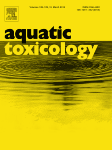Transcription patterns of genes encoding four metallothionein homologs in Daphnia pulex exposed to copper and cadmium are time- and homolog-dependent
Transcription patterns of genes encoding four metallothionein homologs in Daphnia pulex exposed to copper and cadmium are time- and homolog-dependent
 In a recent publication, Asselman et al. (2013) studied the role of metallothioneins, or metal binding proteins, in metal detoxification upon exposure to copper and cadmium. In their study, Asselman et al. (2013) used the freshwater crustacean Daphnia as a model organism but their results will help to elucidate the function of this important protein in other (higher) organisms as well. Indeed, metal pollution has significant impacts on fish (Scientific American).
In a recent publication, Asselman et al. (2013) studied the role of metallothioneins, or metal binding proteins, in metal detoxification upon exposure to copper and cadmium. In their study, Asselman et al. (2013) used the freshwater crustacean Daphnia as a model organism but their results will help to elucidate the function of this important protein in other (higher) organisms as well. Indeed, metal pollution has significant impacts on fish (Scientific American).
Scientific abstract
Metallothioneins are proteins that play an essential role in metal homeostasis and detoxification in nearly all organisms studied to date. Yet discrepancies between outcomes of chronic and acute exposure experiments hamper the understanding of the regulatory mechanisms of their isoforms following metal exposure. Here, we investigated transcriptional differences among four identified homologs (mt1–mt4) in Daphnia pulex exposed across time to copper and cadmium relative to a control. Transcriptional upregulation of mt1 and mt3 was detected on day four following exposure to cadmium, whereas that of mt2 and mt4 was detected on day two and day eight following exposure to copper. These results confirm temporal and metal-specific differences in the transcriptional induction of genes encoding metallothionein homologs upon metal exposure which should be considered in ecotoxicological monitoring programs of metal-contaminated water bodies. Indeed, the mRNA expression patterns observed here illustrate the complex regulatory system associated with metallothioneins, as these patterns are not only dependent on the metal, but also on exposure time and the homolog studied. Further phylogenetic analysis and analysis of regulatory elements in upstream promoter regions revealed a high degree of similarity between metallothionein genes of Daphnia pulex and Daphnia magna, a species belonging to the same genus. These findings, combined with a limited amount of available expression data for D. magna metallothionein genes, tentatively suggest a potential generalization of the metallothionein response system between these Daphnia species.
Full reference
Asselman J, Shaw JR, Glaholt SP, Colbourne JK, De Schamphelaere KAC. 2013. Transcription patterns of genes encoding four metallothionein homologs in Daphnia pulex exposed to copper and cadmium are time- and homolog-dependent. Aquatic Toxicology, 142-143:422-430. doi:10.1016/j.aquatox.2013.09.010
